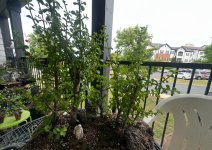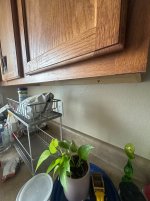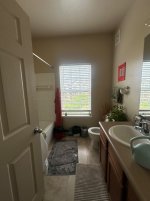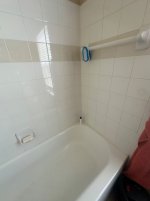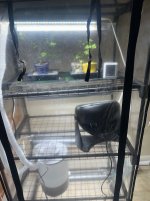You are using an out of date browser. It may not display this or other websites correctly.
You should upgrade or use an alternative browser.
You should upgrade or use an alternative browser.
Jade Forest — Developing
- Thread starter nurvbonsai
- Start date
nurvbonsai
Shohin
Any ideas? Thank you.
Desert O'Piñon
Omono
It looks healthy, so that's a good start. The growth appears a little bit leggy, so it might be somewhat light-deprived. The only thing I would suggest is supplemental lighting, especially if the balcony is its home. My P. afra are all growing in full sun in a box outside, and will be dug out in a couple months and moved indoors for the winter into aquariums with full spectrum lights. They seem to have noticeably shorter internodes in their summer growth outdoors compared to the winter growth, even with 12 hours a day under artificial light.
But I definitely think you have a strong start.
But I definitely think you have a strong start.
nurvbonsai
Shohin
Aw dang. I do have some lighting inside for when it comes in. But I’m worried about watering as I’ve had it in the kitchen before.It looks healthy, so that's a good start. The growth appears a little bit leggy, so it might be somewhat light-deprived. The only thing I would suggest is supplemental lighting, especially if the balcony is its home. My P. afra are all growing in full sun in a box outside, and will be dug out in a couple months and moved indoors for the winter into aquariums with full spectrum lights. They seem to have noticeably shorter internodes in their summer growth outdoors compared to the winter growth, even with 12 hours a day under artificial light.
But I definitely think you have a strong start.
I was thinking of buying one of those shower bars and leaving it there so the water goes into tub but that means the light fixture won’t go there
Gabler
Masterpiece
These need lots of light and little water. I let mine get completely bone dry between waterings, and I keep them in direct, unfiltered, full sunlight (10+ hrs/day). They can handle intense heat without water.
nurvbonsai
Shohin
I’m worried about my set up for inside as I don’t have adequate lighting.
Desert O'Piñon
Omono
They are native to South Africa, where they get little rain and many months of intense sun and heat. Overwatering is the easiest way to hinder or kill these. It's hard to tell from the photo, but it looks like a high organic substrate, which holds a lot of water. They love dry soil. Eventually, and gradually, you'll want to replace organic material with a coarse inorganic mix. Pumice, lava, perlite, and maybe 8822 or something similar. Drainage is crucial. I don't know how much indoor space you have for this, but even in front of a south-facing window, they'll definitely need additional lighting. There are a lot of inexpensive options, and I would recommend researching the best solutions here. Just search "lighting," "supplemental lighting," or "indoor lighting."
Here's my winter setup last year. Cheap, full-spectrum lights with timers, and the curtains are also open during the day. I will probably have to make some adjustments this winter, as these have doubled and/or tripled in size over the summer.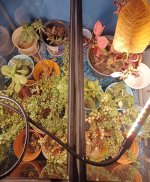
I can get the info on the lighting, but they were inexpensive as far as plant lights go.
Here's my winter setup last year. Cheap, full-spectrum lights with timers, and the curtains are also open during the day. I will probably have to make some adjustments this winter, as these have doubled and/or tripled in size over the summer.

I can get the info on the lighting, but they were inexpensive as far as plant lights go.
nurvbonsai
Shohin
It’s shohin bonsai soil.They are native to South Africa, where they get little rain and many months of intense sun and heat. Overwatering is the easiest way to hinder or kill these. It's hard to tell from the photo, but it looks like a high organic substrate, which holds a lot of water. They love dry soil. Eventually, and gradually, you'll want to replace organic material with a coarse inorganic mix. Pumice, lava, perlite, and maybe 8822 or something similar. Drainage is crucial. I don't know how much indoor space you have for this, but even in front of a south-facing window, they'll definitely need additional lighting. There are a lot of inexpensive options, and I would recommend researching the best solutions here. Just search "lighting," "supplemental lighting," or "indoor lighting."
Here's my winter setup last year. Cheap, full-spectrum lights with timers, and the curtains are also open during the day. I will probably have to make some adjustments this winter, as these have doubled and/or tripled in size over the summer.View attachment 612831
I can get the info on the lighting, but they were inexpensive as far as plant lights go.
nurvbonsai
Shohin
I have a similar light. Just the space of my apartment and what I planned to do might not work best. Where the outlets are and where I planned to put it.They are native to South Africa, where they get little rain and many months of intense sun and heat. Overwatering is the easiest way to hinder or kill these. It's hard to tell from the photo, but it looks like a high organic substrate, which holds a lot of water. They love dry soil. Eventually, and gradually, you'll want to replace organic material with a coarse inorganic mix. Pumice, lava, perlite, and maybe 8822 or something similar. Drainage is crucial. I don't know how much indoor space you have for this, but even in front of a south-facing window, they'll definitely need additional lighting. There are a lot of inexpensive options, and I would recommend researching the best solutions here. Just search "lighting," "supplemental lighting," or "indoor lighting."
Here's my winter setup last year. Cheap, full-spectrum lights with timers, and the curtains are also open during the day. I will probably have to make some adjustments this winter, as these have doubled and/or tripled in size over the summer.View attachment 612831
I can get the info on the lighting, but they were inexpensive as far as plant lights go.
And I used shohin size bonsai soil.
nurvbonsai
Shohin
Desert O'Piñon
Omono
How are you monitoring soil moisture? They naturally thrive in especially dry environments and have very shallow root systems that chug as much water as possible whenever the rain does fall. The chopsticks method works, it's cheap, and it's accurate. You want the soil to be absolutely dry for at least a few days before watering thoroughly. Some people even wait until they notice wilting, although that's not my preference.
Yes, your space is quite limited. But you don't need a lot of room if that is the only thing you're bringing inside for the winter. I have a small coffee table/drawer cabinet in my living room that becomes home for them for a few months. My lights clamp onto the edge of the aquariums in front of an east window. I open the curtains when I leave for work at 0530 and the lights come on at about 0800 for 12 hours. So far, I haven't lost any plants indoors.
I have about 1/2" of aquarium gravel in the bottom so I can water completely, but the pots are lifted above the water that drains from the pots to reduce the risk of overwatering or root rot. As soon as the temperatures start to approach 80° during the day, I take them outside every morning, and then bring them back in around sunset, until the nighttime temperatures are consistently above 50°. However, I keep an eye on the forecast, just in case there's a late cold snap.
None of this makes me any kind of an expert. I'm still in the toddler stages of bonsai, so I hope that anyone will correct any bad information in this thread.
Yes, your space is quite limited. But you don't need a lot of room if that is the only thing you're bringing inside for the winter. I have a small coffee table/drawer cabinet in my living room that becomes home for them for a few months. My lights clamp onto the edge of the aquariums in front of an east window. I open the curtains when I leave for work at 0530 and the lights come on at about 0800 for 12 hours. So far, I haven't lost any plants indoors.
I have about 1/2" of aquarium gravel in the bottom so I can water completely, but the pots are lifted above the water that drains from the pots to reduce the risk of overwatering or root rot. As soon as the temperatures start to approach 80° during the day, I take them outside every morning, and then bring them back in around sunset, until the nighttime temperatures are consistently above 50°. However, I keep an eye on the forecast, just in case there's a late cold snap.
None of this makes me any kind of an expert. I'm still in the toddler stages of bonsai, so I hope that anyone will correct any bad information in this thread.
leatherback
The Treedeemer
I let my jades go dry for winter. Store them in an unheated room, standing at 12c / 50F for winter in semi-darkness seem to do just fine. They ARE bare come spring though. Sop no development over winter.even in front of a south-facing window, they'll definitely need additional lighting
nurvbonsai
Shohin
Naturally I’m relying on what I see as what appears to be a dry soil bed of bonsai soil. We’ve had extreme summer this year so it’s something I’ve been monitoring pretty heavily.How are you monitoring soil moisture? They naturally thrive in especially dry environments and have very shallow root systems that chug as much water as possible whenever the rain does fall. The chopsticks method works, it's cheap, and it's accurate. You want the soil to be absolutely dry for at least a few days before watering thoroughly. Some people even wait until they notice wilting, although that's not my preference.
Yes, your space is quite limited. But you don't need a lot of room if that is the only thing you're bringing inside for the winter. I have a small coffee table/drawer cabinet in my living room that becomes home for them for a few months. My lights clamp onto the edge of the aquariums in front of an east window. I open the curtains when I leave for work at 0530 and the lights come on at about 0800 for 12 hours. So far, I haven't lost any plants indoors.
I have about 1/2" of aquarium gravel in the bottom so I can water completely, but the pots are lifted above the water that drains from the pots to reduce the risk of overwatering or root rot. As soon as the temperatures start to approach 80° during the day, I take them outside every morning, and then bring them back in around sunset, until the nighttime temperatures are consistently above 50°. However, I keep an eye on the forecast, just in case there's a late cold snap.
None of this makes me any kind of an expert. I'm still in the toddler stages of bonsai, so I hope that anyone will correct any bad information in this thread.
It seems Jelle’s advice might be best for the space I’ve had is quite limited to a forest watering and floors etc.
leatherback
The Treedeemer
note the COLD room. The warmer you overwinter them, the more important water management becomes.It seems Jelle’s advice might be best for the space I’ve had is quite limited to a forest watering and floors etc.
nurvbonsai
Shohin
I don’t think it will fit in herenote the COLD room. The warmer you overwinter them, the more important water management becomes.
Attachments
Betula1
Mame
As an alternative do you have well lit windowsills where you could keep them over winter? Ive successfully kept mine indoors in winter like this for over 10 years in an unheated room, then outdoors in a sunny spot from May till October.
nurvbonsai
Shohin
Not conducive to the size of the slab and windowsill. Best look.As an alternative do you have well lit windowsills where you could keep them over winter? Ive successfully kept mine indoors in winter like this for over 10 years in an unheated room, then outdoors in a sunny spot from May till October.

